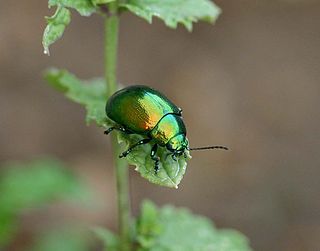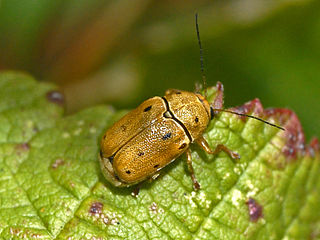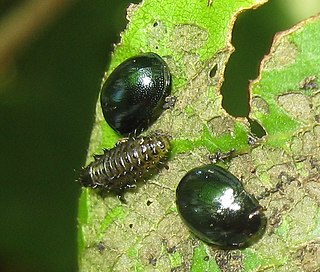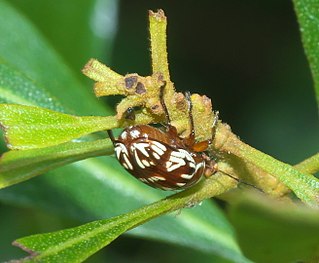
Cryptocephalus is a genus of leaf beetles in the subfamily Cryptocephalinae and belonging to the group of case-bearing leaf beetles called the Camptosomata.

The Cryptocephalini are a tribe within the leaf beetle subfamily Cryptocephalinae. As the other Cryptocephalinae, they belong to the group of case-bearing leaf beetles known as Camptosomata.

Cryptocephalus trimaculatus is a species of cylindrical leaf beetle belonging to the family Chrysomelidae, subfamily Cryptocephalinae.

Cryptocephalus virens is a cylindrical leaf beetle belonging to the family Chrysomelidae, subfamily Cryptocephalinae. The species was first described by Christian Wilhelm Ludwig Eduard Suffrian in 1847.

Cryptocephalus octomaculatus is a species of cylindrical leaf beetles belonging to the family Chrysomelidae, subfamily Cryptocephalinae.
Cryptocephalus cribripennis is a species leaf beetle found in Central America and North America. The specific epithet cribripennis refers to its large, sparse elytral punctures.
Cryptocephalus notatus is a species of case-bearing leaf beetles in the family Chrysomelidae. It is found in North America.

Chrysomelini is a tribe of leaf beetles in the family Chrysomelidae. There are at least 140 described species in Chrysomelini.

Phyllobrotica is a genus of skeletonizing leaf beetles and flea beetles in the family Chrysomelidae. There are at least 18 described species in Phyllobrotica.
Neohaemonia is a genus of aquatic leaf beetles in the family Chrysomelidae. There are at least 4 described species in Neohaemonia.
Cryptocephalus texanus is a species of case-bearing leaf beetle in the family Chrysomelidae. It is found in North America.

Neolema is a genus of leaf beetles in the family Chrysomelidae. Eight described species currently are placed in Neolema.

Tricholochmaea is a genus of skeletonizing leaf beetles and flea beetles in the family Chrysomelidae. There are about 13 described species in Tricholochmaea.

Plateumaris is a genus of aquatic leaf beetles in the family Chrysomelidae. There are about 17 described species in Plateumaris.

Bassareus is a genus of case-bearing leaf beetles in the family Chrysomelidae. There are about eight described species in Bassareus.
Cryptocephalus cupressi is a species of case-bearing leaf beetle in the family Chrysomelidae. It is found in North America.

Cryptocephalus quadruplex is a species of case-bearing leaf beetle in the family Chrysomelidae. It is found in North America.
Cryptocephalus downiei, or Downie's spotted leaf beetle, is a species of case-bearing leaf beetle in the family Chrysomelidae. It is found in North America. The specific epithet downiei honors American psychologist and coleopterist Norville Downie.
Cryptocephalus guttulatus, the fourteen-spotted leaf beetle, is a species of case-bearing leaf beetle in the family Chrysomelidae. It is found in North America.

Cryptocephalus moraei is a species of beetle from the genus Cryptocephalus. The species was originally described by Carl Linnaeus in 1758.













